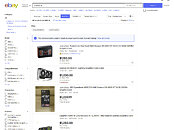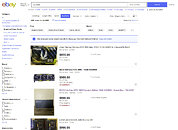Monday, January 11th 2021

We're Changing How we Handle Pricing in Graphics Card Reviews
The major GPU releases in 2020 are all plagued by the same problem: good product, not enough stock. This has led to a perverse situation on the market: you can't just walk into your favorite store and purchase the product you want. This is a consequence of NVIDIA and AMD going to market with tiny volumes, and extremely optimistic MSRPs which opened up the market to the phenomenon of scalping. Scalpers are individuals, or groups, who buy up whatever little volume is available, often using sophisticated online shopping bots, and resell them at exorbitant premiums on marketplaces like eBay, for profit.
This system only works because there is zero retail stock available anywhere on the planet, and whatever volume comes in, is so low that it evaporates, often before hitting retailer shelves. The only way scalping can be defeated is for manufacturers to flood the market with large volumes of product that the scalpers cannot scale their purchases up to, and possibly for crypto-currency mining to become not worth it on the latest generations of graphics cards. Until these happen, marked-up pricing is an inescapable reality for consumers.We believe that exposing readers to MSRP pricing alone in our graphics card reviews, would be doing them disservice. That's why I've decided to consider the pricing of the lowest valid eBay.com listing in my graphics card reviews, too, in cases where none are available on our main retail pricing source, Newegg.com. We do not condone the practice of scalping, but at the same time, it's just not right to report and discuss prices that you can't actually buy the product at.
How We Reported Graphics Card Prices in Our Reviews Until Now
If a price is available on Newegg for the tested product, use that. If not available, possibly because day-one review, for which no other source of information exists, use the MSRP. For the huge list of "reference" comparison cards in reviews, the cheapest Newegg price of the series is used. For older cards, which are no longer in production, the Newegg price can often be too high, because 3rd party sellers are trying to profit. In that case the last available reasonable price point is considered.
How We Intend to Report Pricing Now
I'll try to determine pricing by first looking it up on Newegg, and only use the Newegg price if the product is available (ready to purchase and ship) at the time of writing. For older products nothing changes. If a product is completely sold out on Newegg, like all GeForce RTX 30 and Radeon RX 6800/6900 Series currently, I will look it up on eBay, which is one of the leading marketplaces where people resell their graphics cards.
The search uses the following parameters:
For example, for a hypothetical RX 6700 XT, which is 15% slower than the RX 6800 non-XT (currently going for $850 on eBay, MSRP was $580), I would estimate $700 ($850, minus 15%, minus some premium for lower absolute performance). Obviously this isn't going to be 100% perfect, but I feel that will be more useful than simply parroting back "the MSRP is $400, super affordable, just buy it".
In the review's conclusion I will discuss MSRP, supply situation, the current market price and how that compares to other alternatives on the market. The Performance per Dollar charts will now have the price for calculation appended after the product name. When the MSRP is used, a pink bar with price/performance at MSRP gets added. Comparison cards (gray bars) will be shown at their street price only, MSRP won't be listed. The chart below should illustrate this sufficiently.We welcome your comments and constructive feedback.
This system only works because there is zero retail stock available anywhere on the planet, and whatever volume comes in, is so low that it evaporates, often before hitting retailer shelves. The only way scalping can be defeated is for manufacturers to flood the market with large volumes of product that the scalpers cannot scale their purchases up to, and possibly for crypto-currency mining to become not worth it on the latest generations of graphics cards. Until these happen, marked-up pricing is an inescapable reality for consumers.We believe that exposing readers to MSRP pricing alone in our graphics card reviews, would be doing them disservice. That's why I've decided to consider the pricing of the lowest valid eBay.com listing in my graphics card reviews, too, in cases where none are available on our main retail pricing source, Newegg.com. We do not condone the practice of scalping, but at the same time, it's just not right to report and discuss prices that you can't actually buy the product at.
How We Reported Graphics Card Prices in Our Reviews Until Now
If a price is available on Newegg for the tested product, use that. If not available, possibly because day-one review, for which no other source of information exists, use the MSRP. For the huge list of "reference" comparison cards in reviews, the cheapest Newegg price of the series is used. For older cards, which are no longer in production, the Newegg price can often be too high, because 3rd party sellers are trying to profit. In that case the last available reasonable price point is considered.
How We Intend to Report Pricing Now
I'll try to determine pricing by first looking it up on Newegg, and only use the Newegg price if the product is available (ready to purchase and ship) at the time of writing. For older products nothing changes. If a product is completely sold out on Newegg, like all GeForce RTX 30 and Radeon RX 6800/6900 Series currently, I will look it up on eBay, which is one of the leading marketplaces where people resell their graphics cards.
The search uses the following parameters:
- Brand new
- Ships to the USA
- Sort pricing by "lowest first" (price+shipping)
- Manually inspect and filter out individual listings that look "fake"
- The listing must be ready to purchase ("Buy it Now"), and must ship within 7 days of receipt of payment (ensures that the scalper physically possesses the merchandise they're trying to sell)
For example, for a hypothetical RX 6700 XT, which is 15% slower than the RX 6800 non-XT (currently going for $850 on eBay, MSRP was $580), I would estimate $700 ($850, minus 15%, minus some premium for lower absolute performance). Obviously this isn't going to be 100% perfect, but I feel that will be more useful than simply parroting back "the MSRP is $400, super affordable, just buy it".
In the review's conclusion I will discuss MSRP, supply situation, the current market price and how that compares to other alternatives on the market. The Performance per Dollar charts will now have the price for calculation appended after the product name. When the MSRP is used, a pink bar with price/performance at MSRP gets added. Comparison cards (gray bars) will be shown at their street price only, MSRP won't be listed. The chart below should illustrate this sufficiently.We welcome your comments and constructive feedback.



56 Comments on We're Changing How we Handle Pricing in Graphics Card Reviews
The problem is that the price won't stay like that forever and people should be able to understand if something they are buying is overpriced as hell or not.
In this case, you can't get the product anywhere, so supply and demand works differently.
Fwiw, I wouldn't mind seeing these flagged as paper launches with no mention of the price whatsoever until there's a steady supply to be had.
www.techpowerup.com/img/EWHSdi33jpL0dEH2.jpg
I was able to secure a pseudo backorder from a store in a nearby town that has a supplier.
I think people realize what they want and willing to pay, although with the PpD graph it helps advertises it! That someone gets such level, for forking out an extra 36% appear sensible. Be careful what we promote as the Jeanie might not get stuffed back in the bottle that easy. The entirety of the channel is observing this again, as they did during spikes during mining, and think is this the standard the market could endure? Showing such "unpalatable" pricing could just make it "palatable", and everywhere along the supply chain considers we need our piece of that appropriate.
What does this mean ? Well it clearly means that the MSRP is becoming a bait and switch tool . Just as an example you know your latest and greatest GPU ( product A ) will be sold at no less than 800$ by 3rd party partners ( which you advertise is where the vast majority of your die allocation is going towards) , this would put you in a disadvantage compared to your competition ( product B ) in the eyes of reviewers for various reasons and obviously this will be harmfull for your product , so naturally you pull a 100/150/200$ lower MSRP ( knowing that this applies only to your FE / Stock cooler that you are going to sell in very limited quantities for very limited periods ) which is what said reviewers are going to take into account to make their final recommendation , so magically your GPU ends-up being the recommended product deptite intrinsically being the inferior product .
This is where this new TPU methodology comes to play and this is why i foundamentaly agree with the principle . By showing both advertised MSRP and actual market pricing not only reviewers can wash their hands knowing they are no longer making recomendations based on false values but also customers ( readers ) can easely evaluate themselves how far X or Y product actual value is from it's advertised MSRP and make purchasing decisions based on this . This will push reviewers to put much more emphasis on such practices , which in it's turn will give to readers/customers situational awareness , which ultimately will push companies to stop with said practices or at the very least advertise much more realistic MSRP values !
Before the product launches you could fill the Value part of the review with a determination of what would be a reasonable price. E.g. "for 500 this would be a great card; for 600 this card would be reasonable priced; for 700 this card would be overpriced.
And afterwards, when the real world price turns out the review could be adjusted to that.
Unrealistic msrp price or bait and switch technique are/were screwing the review assessment.
I welcome the initiative
I agree with these changes , the MSRP is irrelevant , perhaps news outlets drumming this fact home might wake these companies up a bit.
I mean 14nm is not so much burdened , surely to FF someone could have made something pliable and worth selling on it And mass manufacturable to sell instead of nothing.
We'll have apple making unicorn GPUs for pc if this shit goes long-term.:p
This is the best post I've seen supporting it, but still not convinced. Off the top, I don't buy the deep state bait and switch argument. These prices are market condition driven and there is always some play among brands - water...is wet.
Let me ask this to W1z....is the price going to get updated in the old reviews as time goes on? If those don't get updated, is that dataset any better than the static MSRP in the first place? What happens if you review a product later in the cycle when availability and pricing is different than the early part of a launch? If someone looks at an older review of said model, they'll find the pricing price to perf. ratio off. In essence, the only place you'll find accurate price to perf. information is from the newest GPU review. That stinks when looking at a specific card... in order to get appropriate data for purchasing you'd read the review with old data, then you'd need to read a, perhaps an unrelated, article to see what the current situation is. So does it add any value, current pricing, even out of the gate?
The chart (the one one the first page of a review, the specs) should have the MSRP listed and a link, where possible to the card. You can use the conclusion or the value section to get your point across about availability and scalping and whatnot... but for main chart, list MSRP and link to NE or Amazon (both of these you can sort by sells by and ships by NE/Amazon... this removes the 3rd party sellers where prices can be wonky - if a user wants to use them, they can do so). Pricing varies wildly anyway by country and vendor... it's not making things any more accurate for most users.
The charts later in the review (example in 1st post) should just be MSRP. If you want to inform the masses, give them a handy equation to check themselves... otherwise with static data, it's just as stale forcing readers to find the latest GPU review to see where it now stands. Good for getting more linking to the latest reviews, for sure.
And please, I just read the first post again, don't estimate scalpers prices for cards...any cards. Rattling it off in text in the article, sure, but using it in a chart... and again with static data... just doesn't age well and is 'obsolete' the second a new review comes out.
As I understand things (which may be the problem... how I'm understanding it).. the new process just feels like it is overcomplicating things for very little ROI to the end user. I'd rather see the time searching for prices and pondering how much a scalper would sell a card, go into cleaning up the (all) articles (fact checking... typos...etc) than this. :)
Then, about a week back ASUS said they were hiking up prices on hardware - we saw upwards of 40% on the list provide in this story on TPU.
Today at MicroCenter I saw a single ASUS 6800 XT ROG on the shelf.....priced at just over a thousand dollars! Holy f-buckets, Batman! Over a grand for a card that maybe should have a premium price of around that $780.
I don't see the benefit of trying to suggest a "possible" retail price of any GPU when it'll just change so rapidly. You'd have to be constantly going back to adjust prices and if you don't price things right you'll piss people and if you change the prices you'll piss people off for whatever reason it would make them mad.
In the end it benefits the customer to know the "MSRP" and the "Street Price" of video cards and I see no harm in providing both.AMD's new 6000 series cards all carry all larger than normal premium.
That's a lot of extra work. You'll need to update the scalp price of every product in the list every time you write an article and the price could fluctuate wildly. Writing it this way could make the pricing chart irrelevant the following week not to mention confusing when comparing two articles.
Address the problem itself, low quantity. In an effort to have the best product on paper, these companies have chosen low volume nodes. With Zen 4 on the 5nm node, being all but gobbled up by Apple, Zen 6000 will be the same story all over again.
This way users can see the price fluctuation even months after the review was published and decide for them self if the current price is too high.
I sure hope it's not fab capacity related, because that would mean the problem will be with us for years to come.
For example there is a specific model in high demand here with a MRSP of $22,000, the wait list is a minimum of 6 months but often over 12 months, the actual selling price through a Dealer is over $30,000, which varies if a buyer wants to offer more to cut their wait.
And no, it is not the tax difference, here the GPUs are minimally +$200 without the tax. I think it is because the EU gets barely any stock compared to the US.
And lets not forget the HW manufacturers greed - the msrp rising for all because of US import tarrifs, which the EU doesn't have and collect. They just pocket the extra money.
I'd also welcome interactive performance/price graph where one can input local prices of several GPUs and (maybe?) even discars certain games they have no interest in playing.
Thanks for this!
How did you confirm "tiny volumes" ?
Thought it was just high demand